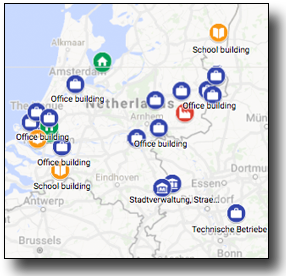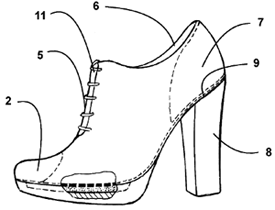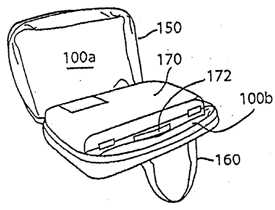 The Phase Change Matters e-mail newsletter is a weekly summary of the latest news and research on phase change materials and thermal energy storage. To subscribe, visit www.puretemp.com/subscribe. For more frequent updates, follow @puretemp on Twitter or visit the Phase Change Matters blog, www.puretemp.com/pcmatters.
The Phase Change Matters e-mail newsletter is a weekly summary of the latest news and research on phase change materials and thermal energy storage. To subscribe, visit www.puretemp.com/subscribe. For more frequent updates, follow @puretemp on Twitter or visit the Phase Change Matters blog, www.puretemp.com/pcmatters.
BUILDING | CONSTRUCTION
New map shows notable PCM building projects around the world
Phase change materials have been improving energy efficiency in homes, schools, office buildings and cold-storage warehouses for more than a decade. Now, for the first time, makers of PCM products and systems can submit their signature projects for inclusion in a Google-based map.
 The new map is maintained by the RAL Quality Association PCM, a European-based organization established in 2004 to develop standards for the PCM industry. Sunamp Ltd., Pluss Advanced Technologies, PCM Technology and other association members are among the early contributors to the map. PCM makers around the world are invited to submit their projects.
The new map is maintained by the RAL Quality Association PCM, a European-based organization established in 2004 to develop standards for the PCM industry. Sunamp Ltd., Pluss Advanced Technologies, PCM Technology and other association members are among the early contributors to the map. PCM makers around the world are invited to submit their projects.
Stefan Thomann, the association’s managing director, explained the map’s purpose.
“PCM products and systems can be used to efficiently regulate temperature and store energy in buildings,” he said. “But the players who are active in this area frequently encounter the prejudice that it is a new technology that is still in its infancy. Well, it isn’t. It is mature and fully developed and has proven its effectiveness numerous times.
“The map shows successful PCM installations around the world to make that point. It is only a start at this point in time, showing only a fraction of the installations, but it will be updated and extended continuously.”
The map now lists information on more than 60 PCM installations. Some of the project descriptions are terse; others offer quite a bit of detail. The most useful listings include the building name, building type, project description, location, PCM application type, manufacturer name, product name, year of installation and a website where more information can be found.
Listings should be sent to s.thomann@pcm-ral.de.
PATENTS
A shoe with improved thermal comfort
U.S. patent application 20180027921 (applicant Miriade S.p.A., Nola, Italy ):
 “A shoe or boot has improved thermal comfort and comprises: an upper having, at the rear counter and the front toe end, a layer of memory foam including phase change microcapsules; an inner lining and an insole impregnated with phase change microcapsules; and a reservoir, obtained in the sole and separated from the inside of the shoe by a perforated insole part, filled up with phase change microcapsules, wherein said phase change microcapsules have a solidification temperature comprised between 18° and 23° C. and a melting temperature comprised between 24° C. and 32° C.”
“A shoe or boot has improved thermal comfort and comprises: an upper having, at the rear counter and the front toe end, a layer of memory foam including phase change microcapsules; an inner lining and an insole impregnated with phase change microcapsules; and a reservoir, obtained in the sole and separated from the inside of the shoe by a perforated insole part, filled up with phase change microcapsules, wherein said phase change microcapsules have a solidification temperature comprised between 18° and 23° C. and a melting temperature comprised between 24° C. and 32° C.”
Heat exchange using phase change material
U.S. patent application 20180031326 (applicant Lockheed Martin Corp., Bethesda, Md.):
“A heat exchange device comprising phase change material-impregnated heat conductive foam disposed between fluid stream channels in a heat exchanger element.”
Thermal storage heat exchanger structures employing PCMs
U.S. patent application 20180031332 (applicant Raytheon Co., Waltham, Mass.):
“A heat exchanger includes at least one conduit configured to carry a working fluid. The heat exchanger also includes a plurality of chambers in proximity to the at least one conduit, each chamber configured to contain a phase change material (PCM) that expands upon freezing. The at least one conduit and the plurality of chambers are thermally coupled for transfer of thermal energy between the working fluid and the PCM in each chamber. One wall of each chamber is formed of a compliant layer configured to deform to increase a volume of the chamber as the PCM expands upon freezing.”
Portable apparatus using PCMs for a temperature-stabilized environment
 U.S. patent application 20180031295 (applicant Fruition LLC, Lexington, Mass.):
U.S. patent application 20180031295 (applicant Fruition LLC, Lexington, Mass.):
“A carrying case utilizes a layer of phase change materials and a thermal insulation layer in order to provide a temperature-stabilized environment for enclosed payloads during transport through an environment in which temperatures differ greatly from those to which they are normally exposed. In one aspect, the phase change materials and thermal insulation provide an extended period of temperature constancy, without the addition of either active thermal control or excessively bulky insulation.”
IN BRIEF
• Nostromo Energy of Israel has introduced the IceBrick, an energy storage system designed to store and discharge an amount of energy equivalent to 25 kWh of electricity consumed by cooling systems at peak demand hours. The 2,000-pound IceBrick contains plain water and a proprietary nucleate.
• A new report from Environment New York, an advocacy organization, says rising renewable energy production means that energy storage is ready for prime time. Thermal storage, utility-scale batteries and pumped-storage hydro are among the technologies discussed in the report, “Making Sense of Energy Storage: How Storage Technologies Can Support a Renewable Energy Future.”
• Ulster University of Northern Ireland has announced 6.7-million-euro cross-border research project to develop energy storage ideas for consumers. The European Union-funded project will explore energy storage methods such as thermochemical material storage and heat pump design.
• The European Parliament has voted in favor of a proposal that would remove palm oil-based biodiesel from the European Union‘s list of renewable fuels by 2021. Indonesia and Malaysia, two of the world’s largest palm oil producers, have been increasingly critical of EU’s plans to phase out palm oil biodiesel, with both countries threatening retaliation in trade and taking the matter to the World Trade Organization.
• A CALMAC thermal energy storage system has helped Kings County Courthouse in Hanford, Calif., achieve LEED Silver Certification and reduce annual energy costs by more than $100,000.
• AkzoNobel is accepting submissions for its 2018 Imagine Chemistry initiative. The company’s specialty chemicals unit is seeking to partner with startups and academics to bring innovative ideas to market.
• New in 2018: Membership in the American Oil Chemists’ Society now includes free online access to three AOCS publications: the Journal of the American Oil Chemists’ Society; the Journal of Surfactants and Detergents; and Lipids.
• Pluss Advanced Technologies of India, maker of the MiraCradle neonate cooler, has signed a collaboration agreement with Dräger, a German-based medical and safety technology company, to spread use of the PCM-enabled device in Asia and Africa.
• Netherland’s Eindhoven University of Technology has openings for three Ph.D. positions involved in the study of crystal hydrate heat storage.
• A Spanish university that has developed new biobased phase change materials with enhanced thermal properties is looking for industrial partners interested in a technical cooperation or a license agreement.
RESEARCH ROUNDUP
For our full list of recent academic research, see puretemp.com/academic. Here are highlights from the past week:
From Data in Brief:• Prediction of the Properties of Eutectic Organic Phase Change Materials
From Energy and Buildings:
• Diatomite/CNTs/PEG composite PCMs with shape-stabilized and improved thermal conductivity: Preparation and thermal energy storage properties
From Solar Energy:
• Thermal performance of phase change materials (PCM)-enhanced cellulose insulation in passive solar residential building walls
From Energy Procedia:
• A Parametric Study about the Potential to Integrate Phase Change Material into Photovoltaic Panel
• Investigations on thermal environment in residential buildings with PCM embedded in external wall
• Passive Cooling Using Phase Change Material and Insulation for High-rise Office Building in Tropical Climate
• A Study on Latent Heat Energy Storage Performance of Tetradecane
• Erythritol-Vermiculite form-stable phase change materials for thermal energy storage
From Applied Thermal Engineering:
• Modification of expanded graphite and its adsorption for hydrated salt to prepare composite PCMs
From Renewable Energy:
• Experimental Investigation of Solar Chimney with Phase Change Material (PCM)
• Effect of retrofitting a silver/water nanofluid-based photovoltaic/thermal (PV/T) system with a PCM-thermal battery for residential applications
From International Journal of Thermal Sciences:
• Thermal charging performance of enhanced phase change material composites for thermal battery design
From Colloids and Surfaces A: Physicochemical and Engineering Aspects:
• Preparation and characterization of high-temperature non-flowing SiO2/EG/paraffin composites by high-temperature refining
From Materials Today: Proceedings:
• Experimental analysis of thermal energy storage by phase change material system for cooling and heating applications
From Materials & Design:
• Thermal conductivity enhancement of phase change materials with form-stable carbon bonded carbon fiber network
From Sustainable Cities and Society:
• Experimental study on thermal performance improvement of building envelopes by integrating with phase change material in an intermittently heated room
From International Journal of Refrigeration:
• Phase-change thermal energy storage using spherical capsules: performance of a test plant
NETWORKING
Connect with PCM experts and industry leaders on LinkedIn
 More than 1,100 people have joined a LinkedIn group devoted to the discussion of phase change material and thermal energy storage. The Phase Change Matters group is an interactive complement to the award-winning blog and newsletter of the same name.
More than 1,100 people have joined a LinkedIn group devoted to the discussion of phase change material and thermal energy storage. The Phase Change Matters group is an interactive complement to the award-winning blog and newsletter of the same name.
You are invited to join the group and connect with PCM and TES experts from around the world. New members include Sarath Kannan, a graduate research assistant at the University of Cincinnati, Ohio; and Xiang Wang, project leader in biomass gasification, hydrogen production and PCMs at the Clean Energy Research Institute, Beijing, China.